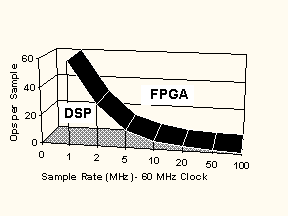
Digital signal processing has traditionally been done using enhanced microprocessors. While the high volume of generic product provides a low cost solution, the performance falls seriously short for many applications. Until recently, the only alternatives were to develop custom hardware (typically board level or ASIC designs), buy expensive fixed function processors (eg. an FFT chip), or use an array of microprocessors.
Recent increases in Field Programmable Gate Array performance and size offer a new hardware acceleration opportunity. FPGAs are an array of programmable logic cells interconnected by a matrix of wires and programmable switches.. Each cell performs a simple logic function defined by a user's program. An FPGA has a large number (64 to over 20,000) of these cells available to use as building blocks in complex digital circuits. Custom hardware has never been so easy to develop
The ability to manipulate the logic at the gate level means you can construct a custom processor to efficiently implement the desired function. By simultaneoulsy performing all of the algorithm’s subfunctions, the FPGA can outperform a DSP by as much as 1000:1.

DSP performance is limited by the serial instruction stream. FPGAs are a better solution in the region above the curve. * Actual performance gains depend on algorithm efficiency, clock rates, degree of parallelism and other factors. Typical gains lie between 10:1 and 1000:1
Like microprocessors, many FPGAs can be infinitely reprogrammed in-circuit in only a fraction of a second. Design revisions, even for a fielded product, can be implemented quickly and painlessly. Hardware can also be reduced by taking advantage of reconfiguration.
The programmable logic in an FPGA can absorb much of the interface and ‘glue’ logic associated with microprocessors. The tighter integration can make a product smaller, lighter, cheaper and lower power.
FPGAs are a generic product customized at the point of use. They enjoy the cost advantages of high production volumes. There are also none of the NRE charges or fabrication delays associated with ASIC development..
The FPGA’s flexibility eliminates the long design cycle associated with ASICs. With FPGAs there are no delays for prototypes or early production volume. Design revisions are easily implemented, often taking less than a day. The devices are fully tested by the manufacturer, eliminating production test development.
We’ve been using FPGAs in DSP designs since 1988 for: